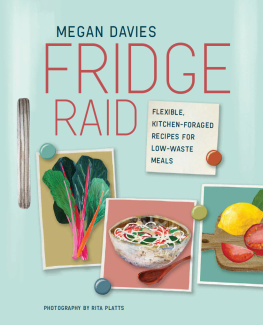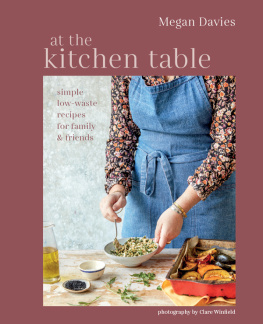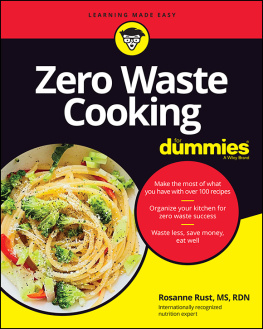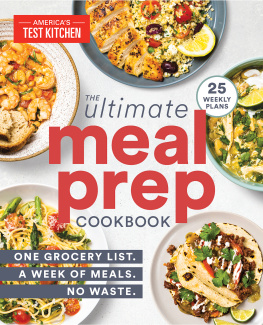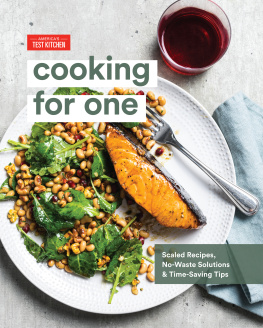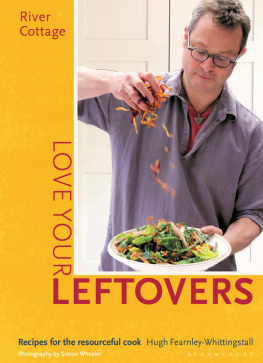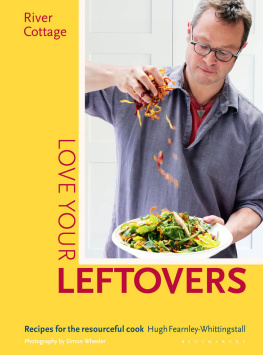FRIDGE RAID


MEGAN DAVIES
FRIDGE
RAID
FLEXIBLE, KITCHEN-FORAGED RECIPES FOR LOW-WASTE MEALS
PHOTOGRAPHY BY RITA PLATTS


DEDICATION
To the wriggling sproglet in my tummy, who has also been a taste tester for the entire book without even knowing!
Senior Designer Megan Smith
Senior Editor Gillian Haslam
Head of Production Patricia Harrington
Art Director Leslie Harrington
Editorial Director Julia Charles
Publisher Cindy Richards
Food Stylist Megan Davies
Food Stylists Assistant Sarah Vassallo
Prop Stylist Hannah Wilkinson
Indexer Hilary Bird
Cover Illustrator Bryony Clarkson
Published in 2021
by Ryland Peters & Small
2021 Jockeys Fields
London WC1R 4BW
and
341 E 116th St
New York NY 10029
www.rylandpeters.com
Text Megan Davies 2021
Design and photographs Ryland Peters & Small 2021
Cover illustration Bryony
Clarkson 2021

ISBN: 978-1-78879-361-2
10 9 8 7 6 5 4 3 2 1
The authors moral rights have been asserted. All rights reserved. No part of this publication may be reproduced, stored in a retrieval system, or transmitted in any form or by any means, electronic, mechanical, photocopying or otherwise, without the prior permission of the publisher.
Printed and bound in China.
CIP data from the Library of Congress has been applied for. A CIP record for this book is available from the British Library.
NOTES
* Both British (metric) and American (imperial plus US cup) measurements are included in these recipes; however, it is important to work with one set of measurements and not alternate between the two within a recipe.
* All butter is salted unless specified.
* All eggs are medium (UK) or large (US), unless specified as large, in which case US extra-large should be used. Uncooked or partially cooked eggs should not be served to the very old, frail, young children, pregnant women or those with compromised immune systems.
* Ovens should be preheated to the specified temperatures.
We recommend using an oven thermometer.
* When a recipe calls for the grated zest of citrus fruit, buy unwaxed fruit and wash well before using. If you can only find treated fruit, scrub well in warm soapy water before using.

CONTENTS

INTRODUCTION
Fridge Raid is an honest, practical and, I hope, very useful cookbook. There arent lists of fancy ingredients or 10-hour recipes scattered across the pages; instead you will find a collection of humble, flexible, simple recipes, the majority of which were originally genuine fridge-foraged meals that I came up with on the spot in my kitchen here in London.
The moment I thought of gathering together all these ideas into a book, I started writing down my recipes, continuing to do so throughout the four seasons and found I had gathered almost a books worth of content! These recipes were conjured up using nothing but a notebook and what I had in the fridge, freezer, cupboard, vegetable rack or fruit bowl. Of course, I then fine-tuned the list and topped up with some new dishes to round things off, but the majority of this book really is a compilation of naturally developed fridge raid meals.
As I hadnt yet shared my book idea with my publisher, this process of invention without pressure not only allowed me to create recipes freely, but it also made me reflect on the way we run our kitchens. Rummaging around to see which limp herbs I needed to use up or which canned beans I might find in the cupboard made me really acknowledge the food and produce we have access to, and, in such a disposable culture, how important it is to cherish each ingredient. How? Simply by using those ingredients in the most efficient and sustainable way, stretching, utilizing, being inventive and flexible! I dont mean fermenting or pickling everything in sight I just mean respecting what weve spent our hard-earned cash on and making it stretch as far as possible. Its also very similar to how our grandparents (and their parents) used to run their kitchens. This is what Fridge Raid is all about.
I have divided the book into six main sections, the majority of which are dictated by the seasons, reflecting the produce that is at its best and the things I particularly crave at those times of year. So youll find warming stews and slow-cook meals in the winter chapter, barbecue recipes and bold salads in the summer chapter, and so on. I have also tried always to include store-cupboard items in every recipe, so that if you cant get hold of the fresh ingredients that I suggest, you can use what youve got.
One of the other recipe chapters that opens the book is Everyday Staples where Ive laid out some basic ingredients you are quite likely to have at home, and based recipes around those hero ingredients. Weve got eggs, cheese, milk and yogurt, bread, then pastry and potatoes. Some of them are very basic, and some of them involve more preparation, but all of them are focused on the staple ingredient. Also at the front of the book is the Kitchen Condiments chapter, where youll find dips, sauces, dressings, spreads and chutneys that can liven up any sandwich, loaded toast, simple supper or boring salad. Theyre very straight forward, too. It can be exhausting to feel as though you have to jazz up every meal of the week (theres also not enough time) but what you can do is make a batch of condiments one slow Sunday, leave them in the fridge and know that when you grab a quick bagel, bowl of soup or eggs on toast, youve got a great additional dip or sauce to freshen things up (and possibly clear out the salad drawer).
So, thats all the chapters explained, which leads me on to telling you about the ingredients tables that Ive conjured up for you. In my last book, I included a couple of notes at the bottom of every single recipe sharing brief swap-in and leftovers ideas, in order to help inspire you to use what youve got and to stretch your food. My ingredients tables are basically a deep dive into this concept and the aim is to encourage you to develop an intuition when it comes to swapping alternative ingredients for the original ones I started with.

On every recipe youll see a simple, two-column table. The left-hand side shows the original ingredients I created the recipe with, which you are more than welcome to abide by; however I actually encourage you to use that as a (close) guide, but then refer to the right-hand column and see the alternative suggestions for other ingredients that would work well, too. This will help you save money, shopping time, energy in all its guises and make use of your existing stock! I have tried to add several alternative ideas for every ingredient, but theres no need to stick even to those, if you have another that you think could work, try it! You cant go too far wrong, I promise. Ive also added tips alongside each recipe, to suggest what goes well with each dish and inspiration for what to do with any leftovers.

